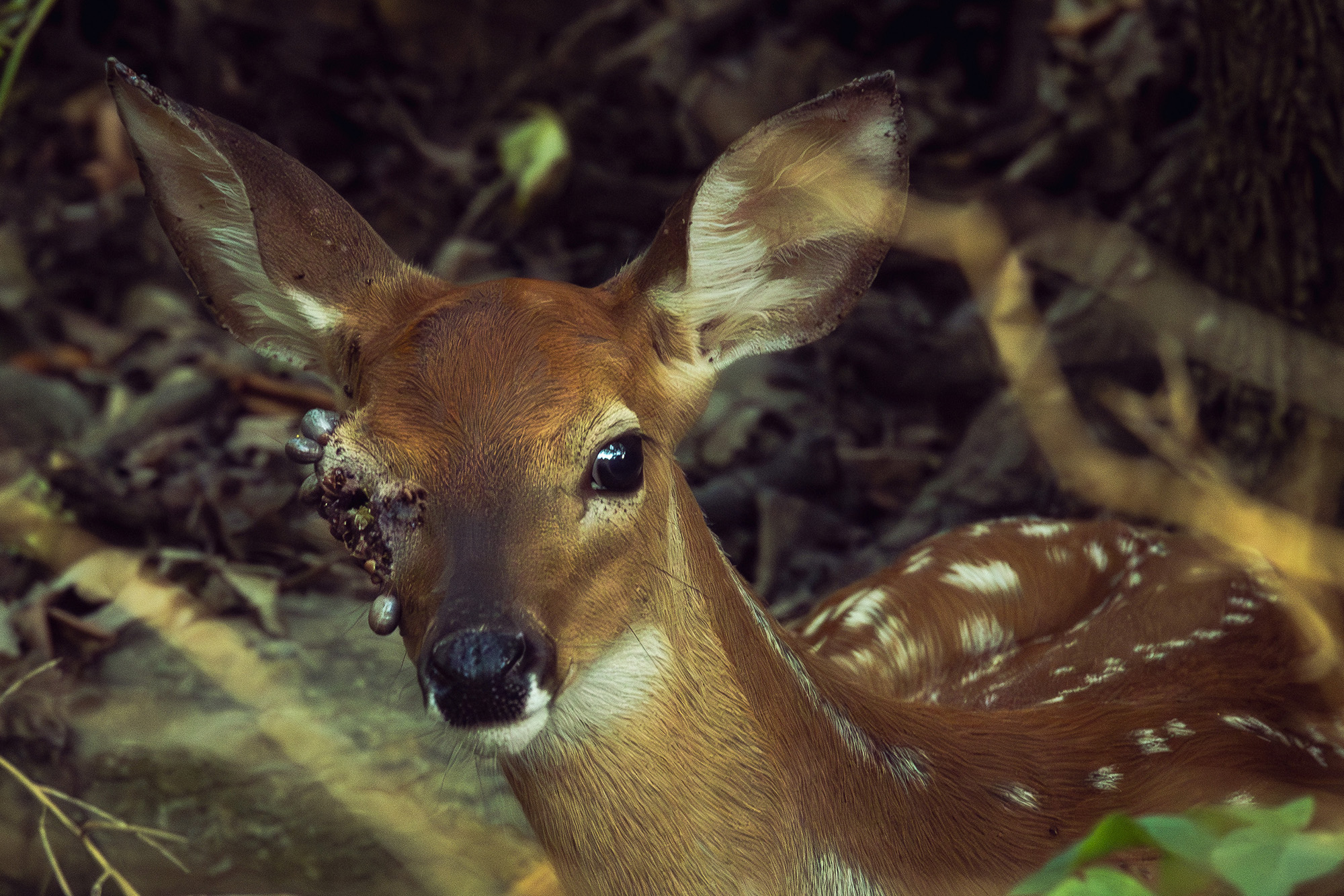Shawn Luchtel was walking behind his house in west-central Missouri on Tuesday when he spotted a fawn. The deer was tucked into a dry creek bed and, like most young fawns, it stayed put instead of fleeing. That gave Luchtel a chance to really look at it, and that’s when he noticed all the ticks covering its swollen right eye.
He snapped a photo that shows a handful of fully-engorged ticks feeding on the right side of the fawn’s skull. The tissue around its eye is swollen and necrotic, with holes in the skin that even contain what look grubs, but may be more ticks. It was difficult for him to assess the extent of the damaged tissue, however, because the fawn wouldn’t turn its head.
“It was almost like it was predominantly wanting to keep its good eye directed toward me, since it couldn’t see out of the other eye,” says Luchtel, who co-owns Heartland Bowhunter. He mentioned that his neighbor had seen what was presumably the same deer — a fawn with its right eye swollen shut — a few days before. Another neighbor down the road sent Luchtel videos (below) of another fawn; both its eyes were swollen with ticks.
Video clips from Luchtel’s neighbor (above) show another fawn in their area with ticks around its eyes.
“We see this in particularly bad tick years,” says Kip Adams, a wildlife biologist and the National Deer Association’s chief conservation officer. “What happens with fawns, particularly in that first week or so of life, is they’re taught to hide and they’re just laying there in cover — in vegetation where ticks are. So unfortunately, early in life during really bad tick years, ticks can get all over these fawns.”
Sometimes does can help remove ticks from their fawns through social grooming, though it’s not always enough to make a difference when ticks are especially thick.
“Early on those [does] are just returning three or four times a day to nurse their fawns, and that gives the ticks a lot of time to really cause harm,” says Adams. “There are examples where people have found fawns that were dead just from having too many ticks on them. They can handle a lot of ticks, which is a good thing, but in situations like this, not only is the loss of all that blood and irritation in a problem, it looks like this fawn can’t see, which then predisposes it to other injuries or death.”
Studies show that predation and natural causes (starvation, disease) are the most common killers of wild whitetail fawns, but ticks can still pose major problems when they are present. One study that looked at fawn mortality in the absence of predators noted that fawns still found plenty of ways to die. That study, which was conducted in Delaware, found that six of 40 fawn carcasses showed signs of lone-star tick parasitism, which was previously thought to be more prevalent in the South.
In a 2015 article from NDA, author Anthony Harris cited The Field Manual of Wildlife Diseases in the Southeastern United States, which notes that “…heavy infestations of [ticks] may produce fawn mortality up to a reported estimate of 30 percent.” He also reported examining 33 Missouri fawns that had “become blinded in both eyes due to the onset of infection from the high volume of ticks surrounding the eye socket.”
“Unfortunately those fawns were euthanized after efforts to improve their condition failed,” he wrote in the article, which contains a photo of a late-spring fawn, its eyes swollen shut with ticks. “While 33 isn’t a large number over a broad landscape, that number came from a single Missouri county, a scenario that played out through many other counties of Southern Missouri that year. One fawn that I and a wildlife rehabilitator worked to save had 316 ticks removed from the right eye and 257 from the left!”
Another study out of Oklahoma in the 1970s found that “blood loss and gross infection resulting from the feeding of lone star ticks (Amhlyomma americanum) were associated with the causes of 71 percent of fawn mortality where causes were determined.” While more research is needed to positively identify a correlation between growing tick numbers and growing concern over ticks harming fawns, it stands to reason that the more ticks there are across whitetail range, the more fawns will be affected by them.
Photo by Shawn Luchtel / Heartland Bowhunter
The significant swelling and tissue damage of the fawn Luchtel photographed, however, is less common in these types of tick infestations, as is the fawn’s larger size. (Once fawns start moving around more as they age, says Adams, they’re less susceptible to ticks.) While it’s possible this particular fawn has a congenital defect or sustained trauma, those are less likely explanations for the fawn’s condition.
“There certainly could have been something wrong with the eye, but that wouldn’t necessarily attract more ticks to that area,” Adams says. “Probably what that is, more than anything else, is the mother biting or pulling those ticks off and causing damage around and particularly below the eye. Or the fawn is rubbing its eye on something to try to give itself a little relief and causing a little damage. The ticks themselves are not likely to cause the decay of that tissue or necrosis.”
Read Next: The Best Tick Repellents
A third, though less likely, possibility is that the fawn ran into something because it couldn’t see, says Adams, and injured the eye. If you have the stomach to look closely, you can see a pocket of green stuff in one pitted hole near the eye; it could be vegetation, such as lichen from a tree trunk where the fawn rubbed its face, or an indication of infection.
Regardless of how the damage happened, says Adams, the fawn’s health is definitely suffering. Still, he’s bullish on its survival prospects given the deer’s size, the absence of excessive ticks elsewhere around its ears and face, and the general hardiness of deer.
“This fawn has a good chance of surviving as long as it doesn’t get a secondary infection from what’s going on around its eye,” says Adams. “However, it looks like it’s going to be compromised from a vision standpoint for the rest of its life. Given how many ticks can affect a deer, this is a lucky fawn.”
Ticks (and Tickborne Diseases) Are on the Rise

The fawn’s condition is also a reminder to hunters that ticks are increasing across the whitetail’s range, and so are tick-borne diseases. Luchtel grew up on the property next door to his home; he remembers only picking up the occasional tick while playing in the woods all summer long as a kid. Now he can’t even walk to his chicken coop in the backyard without them crawling on his feet and legs.
Read Next: How to Identify Common Types of Ticks
“I dread, absolutely dread, even setting foot in the woods right now because I know I’m going to be covered in them,” Luchtel says. “I would most certainly say over the last 30 to 35 years the tick population here has grown exponentially.”

That’s one reason why he was interested in an interview Dr. Grant Woods conducted with two researchers from Oklahoma State University lat year, about how and why ticks have been expanding. One key factor they pointed to was encroachment of Eastern red cedar, and how that correlates to tick numbers.
Luchtel and the rest of the Heartland Bowhunter crew released a video two days ago about cedar eradication in north central Missouri. Their goals were more about improving deer habitat and restoring native vegetation, but if it helps to reduce tick habitat? All the better.
Read the full article here




